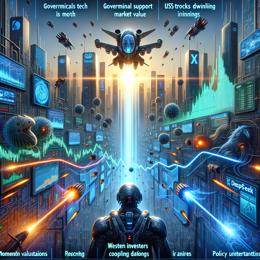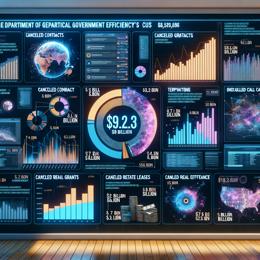Image created by AI
U.S. Stock Market Faces Turbulence and Optimism as 2025 Approaches
As the U.S. stock market nears the end of a tumultuous yet bullish year, investors and analysts are casting a wary eye towards 2025, balancing hope with caution. The recent Federal Reserve's hawkish stance, unexpected by many, led to a "healthy" market correction, as described by experts. Despite the rollercoaster end to 2024, earlier gains driven by AI integration and mega-cap tech companies set a high bar.
The Nasdaq Composite Index, infused by tech dynamism, surged by 33.44 percent this year, marking a historic first by crossing 20,000 points in December. The S&P 500 and Dow Jones Industrial Average weren’t far behind, with their own records shattered throughout the year, boasting increases of 26.63 percent and 24.88 percent, respectively.
However, the optimism was temporarily dimmed when the Fed announced less aggressive rate cuts than expected for 2025, bumping their inflation forecast upwards. This decision spurred a significant market selloff, with the Dow dropping over 1,000 points in a single session. This move, while jarring, was anticipated by some market veterans like Jeremy Siegel of the University of Pennsylvania, who highlighted the market’s overdue correction.
Looking into 2025, sentiments are mixed. On the bullish front, analysts from firms like UBS Global Wealth Management and Bank of America hold lofty targets for the S&P 500, predicting it could reach up to 6,666 and 7,000 points by year's end, respectively. These predictions hinge on continued economic resilience, labor market strength, and escalating AI-driven productivity.
Conversely, the specter of a market bubble looms large with comparisons drawn to the late 1990s. Travis McCourt of Raymond James and Ruchir Sharma of Rockefeller International warn that current market exuberance might mirror the pre-2000 tech bubble, advising prudence amidst rising stocks.
As we edge closer to the forthcoming Donald Trump administration, investor strategies may pivot significantly. The prospect of substantial market corrections in early 2025 juxtaposed against potential robust growth by year-end encapsulates the prevailing uncertainty and the dual-edged sword of high expectations.
Navigating this complex financial landscape will require investors to balance optimism fueled by technological and economic fundamentals against the historical lessons of past market bubbles. The outcome of this delicate balancing act will, undoubtedly, define the economic narrative of 2025.










